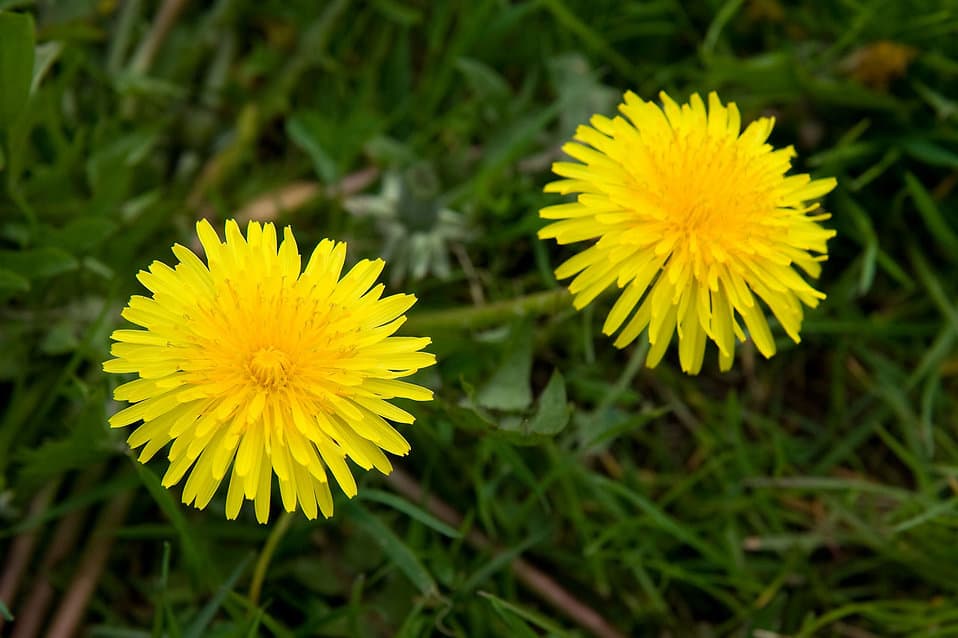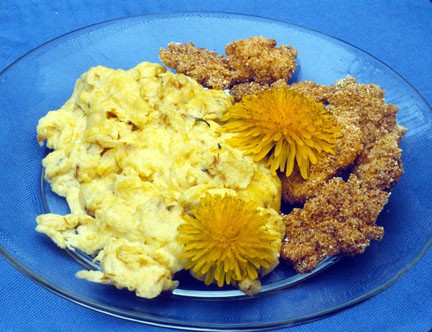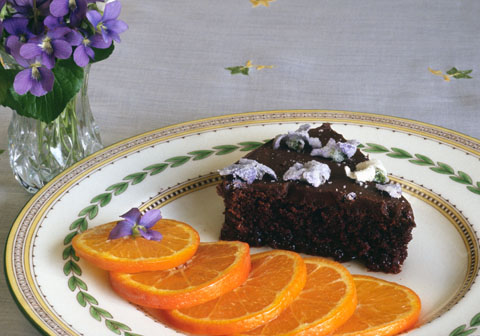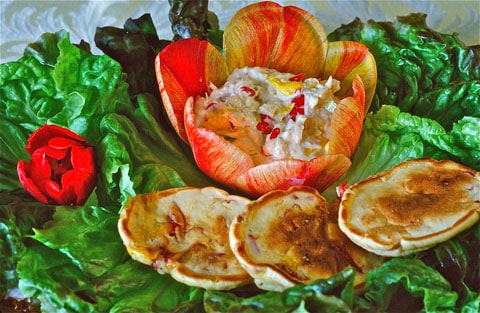
After a long winter is finally over and flowers are bursting forth everywhere, it’s time to start thinking about edible spring flowers.
Edible spring flowers (and some edible summer flowers) grow throughout the garden—and even in the lawn. These flowers do double duty, because they are as attractive outdoors in the yard and the meadow as they are on the plate. And they taste really good.
Let’s look at three spring-blooming edible flowers —dandelions, sweet violets and tulips. While some folks bemoan dandelions and violets in their lawns, I rejoice at the ever-increasing number of lawns that are not pristine green, because the presence of these lively yellow and purple flowers mean that the lawn has not been treated with chemicals. (See The 10 Commandments of Edible Flowers posted here on HG&H.com.) Meanwhile, tulips rarely have any pests or diseases, so there’s no need for any chemical intervention.
Edible Flowers: Dandelion
Native Americans and the American pioneers made great use of all parts of the dandelion (Taraxacum officinale). Even today, the dandelion’s versatility is widely enjoyed.
Dandelion flowers are brewed into tea, wine or beer. The young leaves are delicious in salads or as cooked greens. Dandelion leaves are rich in vitamin C and vitamin A. The flowers contain vitamin C, vitamin A and lesser concentrations of vitamin B1. The roots are often roasted and ground into a coffee substitute. Medicinally, dandelion tea has mild calming effects.

In addition to the recipes below, check out Easy-To-Make (And Delicious!) Dandelion Pesto.
Dandelion Warning: Contact dermatitis has been reported from handling dandelions, likely from the latex in older leaves and stems. Dandelions can be a diuretic (one nickname for dandelions is “piss-a-bed”), so eat them in moderation, early in the day.
DANDELION RECIPES
Here are two of my favorite recipes for dandelion flowers. When served together, Corn Meal Dandies and Dandy Dandelion Eggs make a delicious breakfast.

Corn Meal Dandies
This recipe is a variation of a Native American dish. The slight bite of the cheese is a fine contrast to the sweetness of the flowers. Corn Meal Dandies are delicious battered blossoms that can be served as a side dish, a crunchy garnish or as hors d’oeuvres.
Ingredients
2 eggs
1 tsp. water
1 cup cornmeal
¼ cup finely grated Parmesan cheese
¼ cup peanut or vegetable oil
15 – 20 dandelion flowers, stems removed
Beat eggs with water in a small bowl. Mix cornmeal and cheese in another small bowl. Heat oil in a heavy frying pan until in begins to sizzle. Dip each flower into the egg mixture, then place it in the cornmeal-cheese mixture and gently toss until all surfaces are covered.
Gently drop the coated flower in the hot oil, turning frequently, until it is evenly golden. Drain on a brown paper bag or paper towel.
May be served immediately—hot, or later at room temperature.
Serves 4 to 6.
Dandy Dandelion Eggs
Dandelion buds (immature edible flowers) add an interesting flavor to traditional scrambled eggs. A simple but elegant way to add edible flowers to your breakfast!
Ingredients
1 Tbs. butter
20 dandelion buds
4 eggs
1 Tbs. water
4 dandelion flowers
Melt the butter in a 10″ frying pan over a medium heat. Add the dandelion buds, cooking until they start to open into flowers. Whisk the eggs and water until mixture is light and frothy. Slowly pour the eggs into the cooked buds, stirring gently as the eggs set. Cook to desired consistency. Serve garnished with dandelion flowers.
Serves 4.
Edible Flowers: Sweet Violets
To me, sweet violets (Viola odorata, also commonly known as English violets) are one of the signs that spring has come to stay. Dark green, heart-shaped leaves grow low to the ground in rosettes. Single, sweetly scented flowers appear on 6-inch-long stalks. The flowers range in color from deep violet to rose, and white to mottled white.

SWEET VIOLET RECIPES
Sweetly scented violet flowers can be used in a variety of recipes for syrups, desserts and other sweet treats. Here are four of my favorites.

Oranges with Violet Syrup
A sweet and elegant dessert—with simple ingredients that make an exotic experience for your taste buds.
Ingredients
1 cup water
3 cups sugar
1½ cup violets
3 oranges
In a non-aluminum saucepan, boil water, sugar and violets for 10 minutes or until thickened into a syrup. Strain through cheesecloth into a clean glass jar. Seal and store in the refrigerator for up to two weeks.
Slice oranges and cut in half. Arrange the slices on plates and drizzle with violet syrup. Garnish, if desired, with candied violets (see recipe below for candying flowers).
Serves 4 to 6.
NOTE: Darker-colored flowers yield a darker syrup.
Chocolate Violet Cake
Your kids and grandkids are going to love this! And so will all of the adults you know. For a completely decadent presentation, pour Violet Syrup on the plate, add Oranges with Violet Syrup on the side and place a piece of cake in the middle.
Ingredients
2 cups cake flour
½ cup unsweetened cocoa
2½ tsp. baking powder
1 tsp. salt
1-1/3 cups Violet Sugar (see recipe below)
¾ cup butter
3 eggs
1 tsp. vanilla extract
½ cup milk
Preheat oven to 350 degrees F. Sift together flour, cocoa, baking powder and salt in a bowl. Set aside. Cream together sugar and butter in a large bowl. Add 1 egg, and continue to beat until light and fluffy. The remaining eggs can now be added, beating after each addition. Add vanilla. Alternate adding flour mixture and milk into creamed butter mixture, gently folding to mix ingredients.
Lightly grease and flour two 9″ cake pans. Divide batter between the two pans. Bake about 20 to 25 minutes. When done, the top will spring back when gently pressed and a toothpick inserted into center of cake will come out clean. Remove from oven and cool the pans on a wire rack for 10 minutes. Gently remove cakes from pans, and cool completely on wire rack.
Decorate with your favorite icing (either chocolate or vanilla is good on this cake), or simply dust with confectioner’s sugar. Candied Violets (see recipe below) can add the finishing touch to this sinfully delicious dessert.
Serves 10 – 12.
Violet Sugar
Adding just one ingredient—sweet violet edible flowers—turns ordinary sugar into something magical.
Ingredients
2 cups granulated sugar
2 cups violets
Process sugar and violets in a food processor until thoroughly mixed and violets are in small pieces. Pour mixture into a large, glass bowl and cover with cheesecloth.
Place in a cool dry place for at least a week to allow the flavor of the violets to meld into the sugar. Stir occasionally so the sugar does not become moist. When flavor has fully developed, store sugar in a tightly closed jar.
Candied Violets
Time consuming, but oh so delicious! This recipe also works for other edible flowers including pansies, Johnny jump-ups, rose petals, lilac, borage, pea, pinks and scented geraniums.
Ingredients
1 egg white
100 proof vodka
superfine granulated sugar (Bartenders sugar)
1 narrow artist’s paintbrush
violets
wire cake rack
baking parchment
In small bowl, beat the egg to a light froth (not foamy). Add 1 or 2 drops of vodka and mix. This helps the flower to dry quicker. Pour sugar into a shallow bowl.
Have the paintbrush at hand and some freshly picked violets. I find it best to pick no more than 4 or 5 at a time, candy them, and then pick more. Even with putting them in water, the flowers wilt quickly, which makes the process more difficult. Cover a wire cake rack with baking parchment. Now you are ready to start.
Grasp the top of the stem of a violet between thumb and forefinger. Dip the paintbrush in the beaten egg white. Gently paint all surfaces of the flower; be sure to get between all petals. Gently sprinkle the sugar on the flower, making sure to cover all surfaces and between the petals. Place the flower on the parchment, face up. Repeat process with another flower.
Do not be discouraged; this is a slow process, which requires meticulous attention to detail. When you have done as many flowers as it takes to fill the parchment, place them (still on the rack) in a cool, dry, well-ventilated area to dry completely.* When dry, the flowers will be stiff and brittle.
Gently place the candied flowers in a heavy-duty plastic freezer container, layered no more than three-deep, separated with a sheet of baking parchment between each layer. Keep them in the freezer up to a year. If you store them at room temperature, the humidity creeps in and they can turn into green mush after a couple of months.
* If you live in a very humid area, it can complicate matters. I dry the flowers in a room with a dehumidifier.
Edible Flowers: Tulips
Tulips (Tulipa spp.) are the most popular and widely planted bulbs, with more than 100 species and thousands of cultivated varieties.

The flavor of tulip petals varies, but it is usually pea- or bean-like, occasionally with a green apple overtone. Generally, red, yellow, orange and pink flowers have the best flavor. Cut off ¼ to ½” of the base of the petal where it attached to the stem. This part of the petal is usually white, and it may be bitter. The rest of the base is somewhat fleshy, adding a nice crunch.
TULIP RECIPES
The fact that tulips are edible flowers is not widely known. Well, not as well known as dandelions being edible. Tulip Dandelion Pancakes and Tulip Tuna are two of my favorite recipes that use tulip petals as a featured ingredient. These recipes are as delicious as they are memorable.

Tulip Dandelion Pancakes
A Sunday brunch is made special by serving colorful and unusual fare. Serve Tulip Dandelion Pancakes with a flower butter or flower syrup. Or eat them plain or with a dollop of sour cream. Delicious served hot or at room temperature.
Ingredients
1 cup flour
2 tsp. baking powder
1/8 tsp. salt
½ cup milk
2 eggs
30 dandelion flowers
15 tulips (I like a mixture of brightly colored petals—yellow, red, orange)
Sift together the dry ingredients. In a small bowl, beat the eggs and milk. Cut the petals from the dandelions—save the petals and discard the rest of the flower. Slice the tulip petals into ¼” strips. Add the dry ingredients and the flower petals to the wet ingredients. Stir until moistened.
Pour batter (make 2″ rounds or whatever size you wish) onto a hot, non-stick frying pan. Turn pancakes when the bubbles on the top have broken. Cook for about a minute or until other side browns. Serve immediately.
Serves 6.
NOTE: The batter can be made up to 6 hours ahead of time.
Tulip Tuna
When I serve this, people often say how flavorful the tuna salad is. After everyone is done eating, the whole tulip is usually left on everyone’s plate but mine.
When I ask how they liked the tulips, they may roll their eyes and look at me as if to say, “She’s eaten too many flowers, can’t she see the tulip is still on my plate.”
I quickly tell them that tulips were chopped in the salad, adding to its unique flavor—they had indeed eaten the flowers!
Ingredients
12 brightly colored tulips (reds, yellows, oranges or multicolored are preferable)
2 cans albacore tuna packed in water, drained
4 stalks of celery, coarsely chopped
1 tsp. curry powder
1/3 cup mayonnaise (not salad dressing)
Lettuce leaves (colorful loose-leaf lettuces make a showy plate)
Remove the petals from eight of the tulips and julienne them. In a large bowl, mix the tuna, celery, curry and mayonnaise. Add the julienned petals and gently toss. Cut off the stems and remove the pistils and stamens from the 4 reserved tulips. Lay each tulip on a bed of lettuce leaves. Gently spoon the tuna mixture into the tulips.
Serves 4.
All photos and recipes © 2019 Cathy Wilkinson Barash
——————–
Cathy Wilkinson Barash (also known as The Blooming Gourmet) is the author of Edible Flowers from Garden to Palate, a delightful book that contains 280 recipes for 67 different flowers. She is also the author of Edible Flowers: Drinks & Desserts.



Leave a Reply